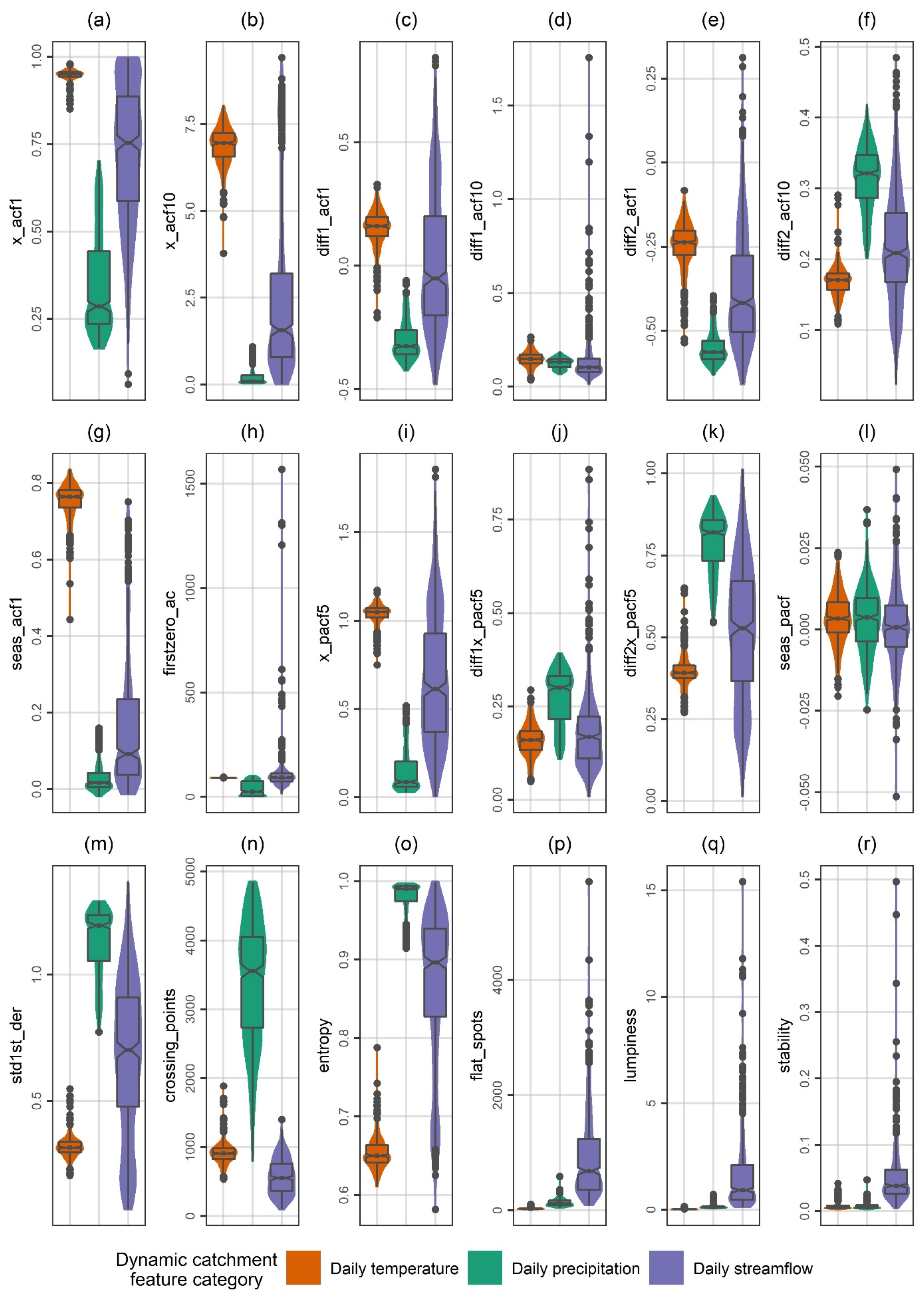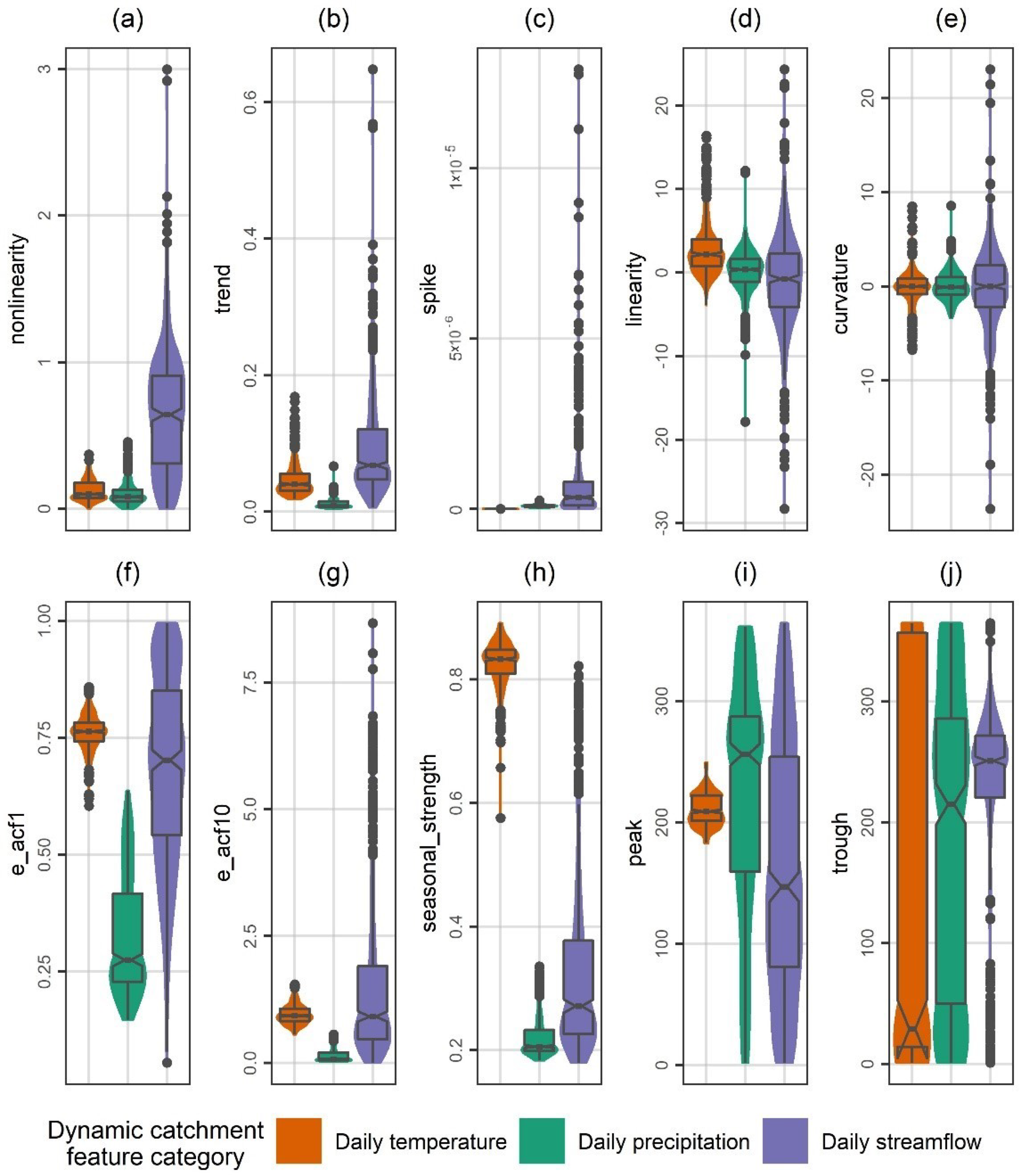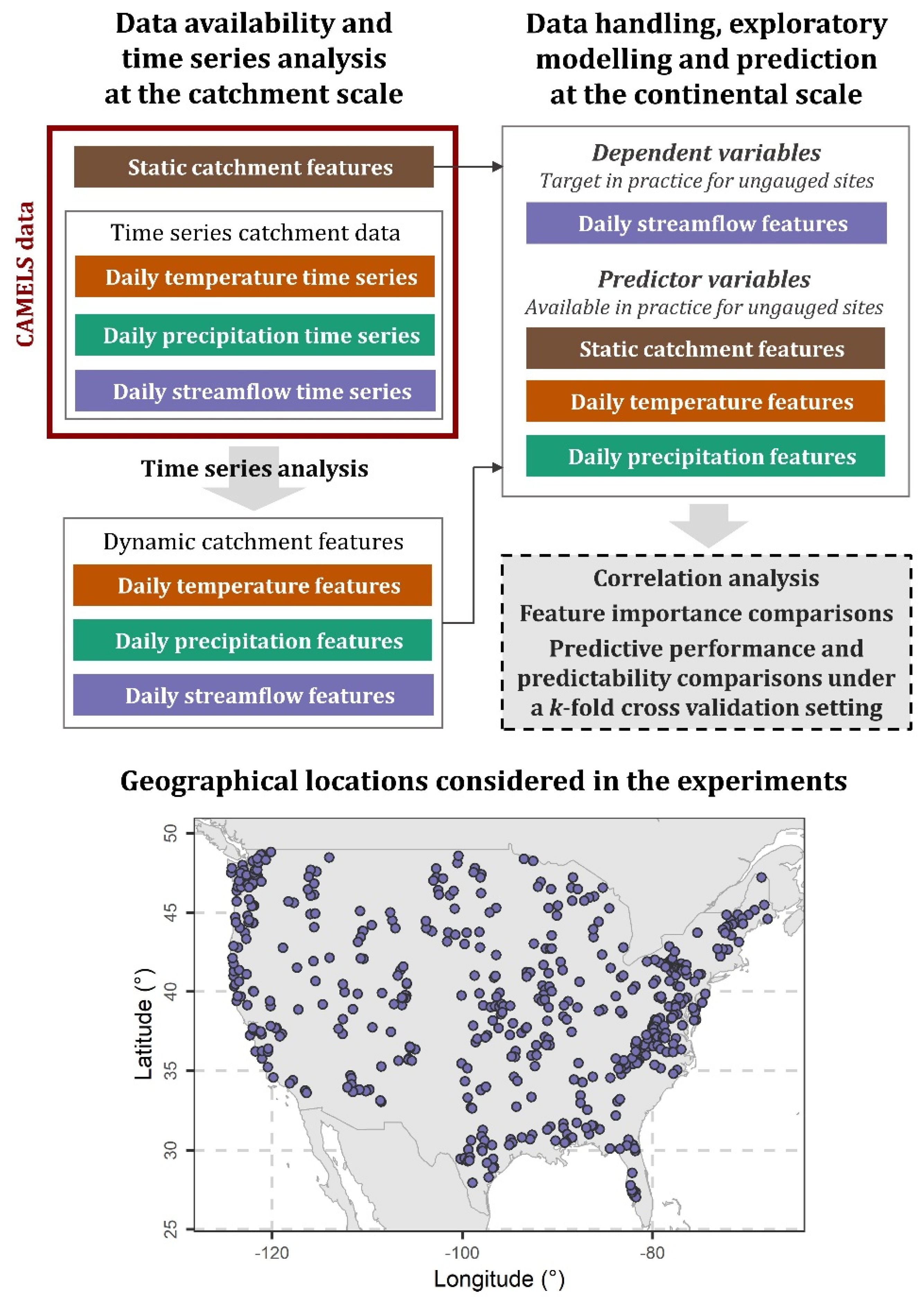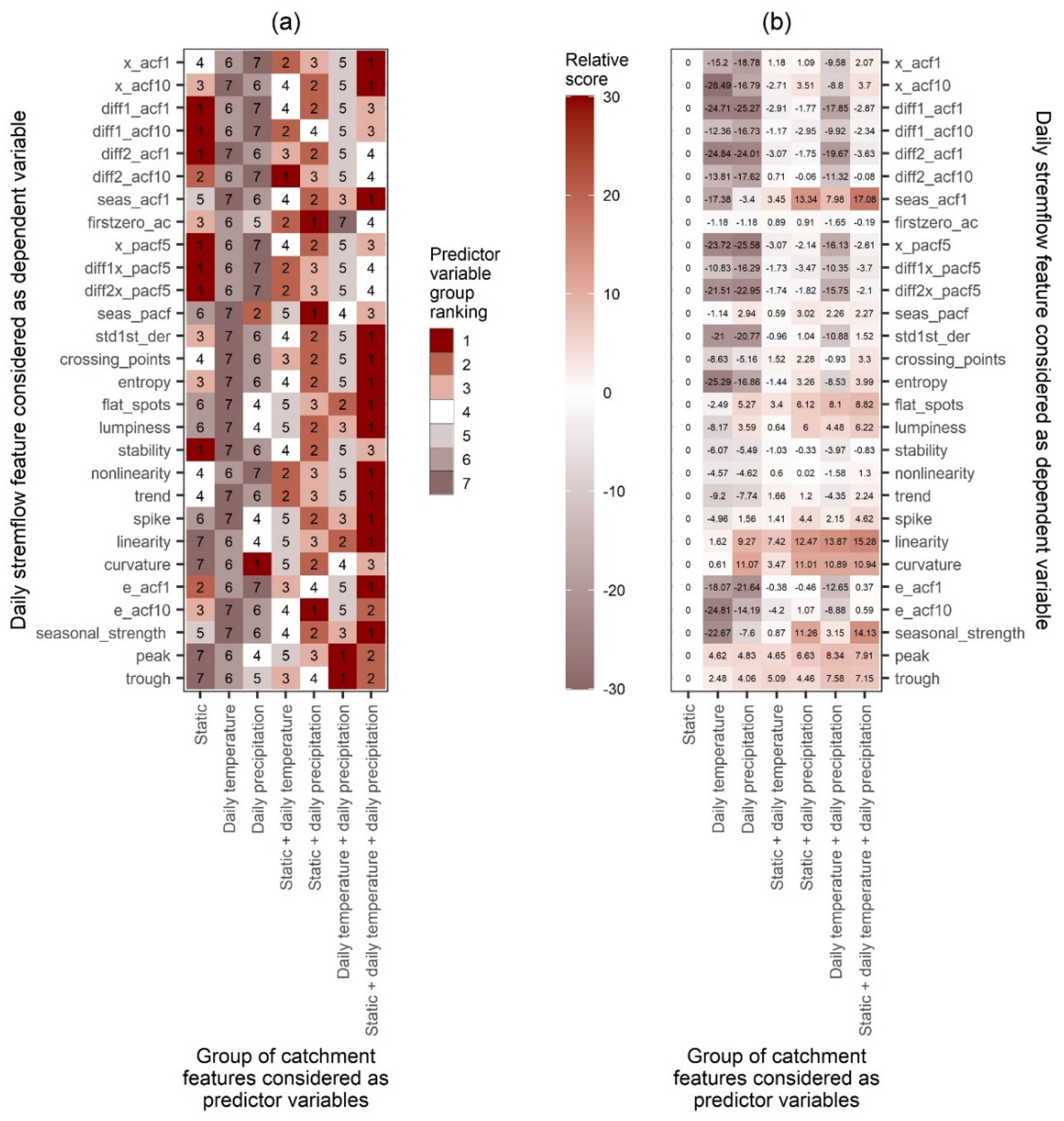Time Series Features for Supporting Hydrometeorological Explorations and Predictions in Ungauged Locations Using Large Datasets
Abstract
:1. Introduction
2. Methods and Data
2.1. Experimental Dataset
- Logarithm of the mean elevation of the catchment (log_elev_mean);
- Logarithm of the mean slope of the catchment (log_slope_mean);
- Logarithm of the GAGESII estimate of the catchment area (log_area_gages2);
- Forest fraction of the catchment (frac_forest);
- Maximum monthly mean of the leaf area index of the catchment (lai_max);
- Green vegetation fraction difference of the catchment (gvf_diff);
- Dominant land cover fraction of the catchment (dom_land_cover_frac);
- Depth to bedrock of the catchment (soil_depth_pelletier);
- Soil depth of the catchment (soil_depth_statsgo);
- Maximum water content of the soil of the catchment (max_water_content);
- Sand fraction of the soil of the catchment (sand_frac);
- Silt fraction of the soil of the catchment (silt_frac);
- Clay fraction of the soil of the catchment (clay_frac);
- Water fraction of the soil of the catchment (water_frac);
- Organic material fraction of the soil of the catchment (organic_frac);
- Fraction of soil of the catchment marked as other (other_frac);
- Carbonate sedimentary rock fraction of the catchment (carbonate_rocks_frac);
- Subsurface porosity of the catchment (geol_porosity);
- Subsurface permeability of the catchment (geol_permeability).
2.2. Time Series Analysis
- Lag-1 sample autocorrelation of the time series (x_acf1);
- Sum of the squared sample autocorrelation values of the time series at the first ten lags (x_acf10);
- Lag-1 sample autocorrelation of the first-order differenced time series (diff1_acf1);
- Sum of the squared sample autocorrelation values of the first-order differenced time series at the first ten lags (diff1_acf10);
- Lag-1 sample autocorrelation of the second-order differenced time series (diff2_acf1);
- Sum of the squared sample autocorrelation values of the second-order differenced time series at the first ten lags (diff2_acf10);
- Lag-365 sample autocorrelation of the time series (seas_acf1);
- Lag at which the first zero crossing of the autocorrelation function is attained (firstzero_ac);
- Sum of the squared sample partial autocorrelation values of the time series at the first five lags (x_pacf5);
- Sum of the squared sample partial autocorrelation values for the first five lags of the first-order differenced time series (diff1x_pacf5);
- Sum of the squared sample partial autocorrelation values for the first five lags of the second-order differenced time series (diff2x_pacf5);
- Lag-365 sample partial autocorrelation (seas_pacf);
- Standard deviation of the first-order differenced time series (std1st_der);
- Number of times that the time series crosses the median (crossing_points);
- Spectral entropy of the time series (entropy);
- Number of flat spots in the time series (flat_spots);
- Lumpiness of the time series (lumpiness);
- Stability of the time series (stability);
- Nonlinearity of the time series (nonlinearity);
- Trend strength of the time series (trend);
- Strength of spikes in the time series (spike);
- Linearity of the time series (linearity);
- Curvature of the time series (curvature);
- Lag-1 sample autocorrelation of the remainder component of the time series, which is obtained after removing the trend and seasonal components (e_acf1);
- Sum of the squared sample autocorrelation values of the remainder component of the time series at the first ten time lags (e_acf10);
- Seasonality strength of the time series (seasonal_strength);
- Strength of peaks in the seasonal component of the time series (peak);
- Strength of troughs in the seasonal component of the time series (trough).
2.3. Correlation Analysis
2.4. Feature Importance Comparisons
2.5. Predictive Performance Comparisons
2.6. Feature Predictability Comparison
3. Results
3.1. Feature Correlations
3.2. Feature Importance Comparisons
3.3. Predictive Performance Comparisons
3.4. Feature Predictability Comparison
4. Discussion
5. Summary and Conclusions
Author Contributions
Funding
Institutional Review Board Statement
Informed Consent Statement
Data Availability Statement
Acknowledgments
Conflicts of Interest
Appendix A
Appendix B


References
- He, Y.; Bárdossy, A.; Zehe, E. A review of regionalisation for continuous streamflow simulation. Hydrol. Earth Syst. Sci. 2011, 15, 3539–3553. [Google Scholar] [CrossRef] [Green Version]
- Sivapalan, M.; Takeuchi, K.; Franks, S.W.; Gupta, V.K.; Karambiri, H.; Lakshmi, V.; Liang, X.; McDonnell, J.J.; Mediondo, E.M.; O’Connell, P.E.; et al. IAHS Decade on Predictions in Ungauged Basins (PUB), 2003–2012: Shaping an exciting future for the hydrological sciences. Hydrol. Sci. J. 2003, 48, 857–880. [Google Scholar] [CrossRef] [Green Version]
- Hrachowitz, M.; Savenije, H.H.G.; Blöschl, G.; McDonnell, J.J.; Sivapalan, M.; Pomeroy, J.W.; Arheimer, B.; Blume, T.; Clark, M.P.; Ehret, U.; et al. A decade of Predictions in Ungauged Basins (PUB)—A review. Hydrol. Sci. J. 2013, 58, 1198–1255. [Google Scholar] [CrossRef]
- Montanari, A.; Young, G.; Savenije, H.H.G.; Hughes, D.; Wagener, T.; Ren, L.L.; Koutsoyiannis, D.; Cudennec, C.; Toth, E.; Grimaldi, S.; et al. “Panta Rhei—Everything Flows”: Change in hydrology and society—The IAHS Scientific Decade 2013–2022. Hydrol. Sci. J. 2013, 58, 1256–1275. [Google Scholar] [CrossRef]
- Blöschl, G.; Bierkens, M.F.P.; Chambel, A.; Cudennec, C.; Destouni, G.; Fiori, A.; Kirchner, J.W.; McDonnell, J.J.; Savenije, H.H.G.; Sivapalan, M.; et al. Twenty-three Unsolved Problems in Hydrology (UPH)—A community perspective. Hydrol. Sci. J. 2019, 64, 1141–1158. [Google Scholar] [CrossRef] [Green Version]
- Guo, Y.; Zhang, Y.; Zhang, L.; Wang, Z. Regionalization of hydrological modeling for predicting streamflow in ungauged catchments: A comprehensive review. Wiley Interdiscip. Rev. Water 2021, 8, e1487. [Google Scholar] [CrossRef]
- Merz, R.; Blöschl, G. Flood frequency regionalisation—Spatial proximity vs. catchment attributes. J. Hydrol. 2005, 302, 283–306. [Google Scholar] [CrossRef]
- Aziz, K.; Rahman, A.; Fang, G.; Shrestha, S. Application of artificial neural networks in regional flood frequency analysis: A case study for Australia. Stoch. Environ. Res. Risk Assess. 2014, 28, 541–554. [Google Scholar] [CrossRef]
- Rahman, A.; Haddad, K.; Kuczera, G.; Weinmann, P.E. Regional flood methods. In Australian Rainfall and Runoff: A Guide To Flood Estimation. Book 3, Peak Flow Estimation; Ball, J., Babister, M., Nathan, R., Weeks, B., Weinmann, E., Retallick, M., Testoni, I., Eds.; Commonwealth of Australia: Clayton, Australia, 2019; pp. 105–146. [Google Scholar]
- Tyralis, H.; Papacharalampous, G.A.; Tantanee, S. How to explain and predict the shape parameter of the generalized extreme value distribution of streamflow extremes using a big dataset. J. Hydrol. 2019, 574, 628–645. [Google Scholar] [CrossRef]
- Rahman, A.S.; Khan, Z.; Rahman, A. Application of independent component analysis in regional flood frequency analysis: Comparison between quantile regression and parameter regression techniques. J. Hydrol. 2020, 581, 124372. [Google Scholar] [CrossRef]
- Fischer, S.; Schumann, A.H. Regionalisation of flood frequencies based on flood type-specific mixture distributions. J. Hydrol. X 2021, 13, 100107. [Google Scholar] [CrossRef]
- Beck, H.E.; de Roo, A.; van Dijk, A.I.J.M. Global maps of streamflow characteristics based on observations from several thousand catchments. J. Hydrometeorol. 2015, 16, 1478–1501. [Google Scholar] [CrossRef]
- Westerberg, I.K.; Wagener, T.; Coxon, G.; McMillan, H.K.; Castellarin, A.; Montanari, A.; Freer, J. Uncertainty in hydrological signatures for gauged and ungauged catchments. Water Resour. Res. 2016, 52, 1847–1865. [Google Scholar] [CrossRef] [Green Version]
- Addor, N.; Nearing, G.; Prieto, C.; Newman, A.J.; Le Vine, N.; Clark, M.P. A ranking of hydrological signatures based on their predictability in space. Water Resour. Res. 2018, 54, 8792–8812. [Google Scholar] [CrossRef]
- Tyralis, H.; Papacharalampous, G.A.; Langousis, A.; Papalexiou, S.M. Explanation and probabilistic prediction of hydrological signatures with statistical boosting algorithms. Remote Sens. 2021, 13, 333. [Google Scholar] [CrossRef]
- Laimighofer, J.; Melcher, M.; Laaha, G. Parsimonious statistical learning models for low-flow estimation. Hydrol. Earth Syst. Sci. 2022, 26, 129–148. [Google Scholar] [CrossRef]
- McMillan, H.; Westerberg, I.; Branger, F. Five guidelines for selecting hydrological signatures. Hydrol. Process. 2017, 31, 4757–4761. [Google Scholar] [CrossRef] [Green Version]
- McMillan, H. Linking hydrologic signatures to hydrologic processes: A review. Hydrol. Process. 2020, 34, 1393–1409. [Google Scholar] [CrossRef]
- Parajka, J.; Merz, R.; Blöschl, G. A comparison of regionalisation methods for catchment model parameters. Hydrol. Earth Syst. Sci. 2005, 9, 157–171. [Google Scholar] [CrossRef] [Green Version]
- Oudin, L.; Andréassian, V.; Perrin, C.; Michel, C.; Le Moine, N. Spatial proximity, physical similarity, regression and ungagged catchments: A comparison of regionalization approaches based on 913 French catchments. Water Resour. Res. 2008, 44, W03413. [Google Scholar] [CrossRef]
- Pool, S.; Vis, M.; Seibert, J. Regionalization for ungauged catchments—Lessons learned from a comparative large-sample study. Water Resour. Res. 2021, 57, e2021WR030437. [Google Scholar] [CrossRef]
- Wang, X.; Smith, K.; Hyndman, R.J. Characteristic-based clustering for time series data. Data Min. Knowl. Discov. 2006, 13, 335–364. [Google Scholar] [CrossRef]
- Fulcher, B.D.; Little, M.A.; Jones, N.S. Highly comparative time-series analysis: The empirical structure of time series and their methods. J. R. Soc. Interface 2013, 10, 20130048. [Google Scholar] [CrossRef] [PubMed]
- Fulcher, B.D.; Jones, N.S. Highly comparative feature-based time-series classification. IEEE Trans. Knowl. Data Eng. 2014, 26, 3026–3037. [Google Scholar] [CrossRef] [Green Version]
- Hyndman, R.J.; Wang, E.; Laptev, N. Large-Scale Unusual Time Series Detection. In Proceedings of the 2015 IEEE International Conference on Data Mining Workshop (ICDMW), Atlantic City, NJ, USA, 14−17 November 2015; pp. 1616–1619. [Google Scholar] [CrossRef]
- Fulcher, B.D.; Jones, N.S. hctsa: A computational framework for automated time-series phenotyping using massive feature extraction. Cell Syst. 2017, 5, 527–531. [Google Scholar] [CrossRef]
- Kang, Y.; Hyndman, R.J.; Smith-Miles, K. Visualising forecasting algorithm performance using time series instance spaces. Int. J. Forecast. 2017, 33, 345–358. [Google Scholar] [CrossRef] [Green Version]
- Fulcher, B.D. Feature-based time-series analysis. In Feature Engineering for Machine Learning and Data Analytics; Dong, G., Liu, H., Eds.; CRC Press: Boca Raton, FL, USA, 2018; pp. 87–116. [Google Scholar]
- Kang, Y.; Hyndman, R.J.; Li, F. GRATIS: GeneRAting TIme Series with diverse and controllable characteristics. Stat. Anal. Data Min. ASA Data Sci. J. 2020, 13, 354–376. [Google Scholar] [CrossRef]
- Hyndman, R.J.; Kang, Y.; Montero-Manso, P.; Talagala, T.; Wang, E.; Yang, Y.; O’Hara-Wild, M. tsfeatures: Time Series Feature Extraction. R Package Version 1.0.2. 2020. Available online: https://CRAN.R-project.org/package=tsfeatures (accessed on 4 April 2022).
- Papacharalampous, G.A.; Tyralis, H. Hydrological time series forecasting using simple combinations: Big data testing and investigations on one-year ahead river flow predictability. J. Hydrol. 2020, 590, 125205. [Google Scholar] [CrossRef]
- Donoho, D. 50 years of data science. J. Comput. Graph. Stat. 2017, 26, 745–766. [Google Scholar] [CrossRef]
- Papacharalampous, G.A.; Tyralis, H.; Papalexiou, S.M.; Langousis, A.; Khatami, S.; Volpi, E.; Grimaldi, S. Global-scale massive feature extraction from monthly hydroclimatic time series: Statistical characterizations, spatial patterns and hydrological similarity. Sci. Total Environ. 2021, 767, 144612. [Google Scholar] [CrossRef]
- Papacharalampous, G.A.; Tyralis, H.; Pechlivanidis, I.; Grimaldi, S.; Volpi, E. Massive feature extraction for explaining and foretelling hydroclimatic time series forecastability at the global scale. Geosci. Front. 2022, 13, 101349. [Google Scholar] [CrossRef]
- Newman, A.J.; Sampson, K.; Clark, M.P.; Bock, A.; Viger, R.J.; Blodgett, D. A Large-Sample Watershed-Scale Hydrometeorological Dataset for the Contiguous USA; UCAR/NCAR: Boulder, CO, USA, 2014. [Google Scholar] [CrossRef]
- Addor, N.; Newman, A.J.; Mizukami, N.; Clark, M.P. Catchment Attributes for Large-Sample Studies; UCAR/NCAR: Boulder, CO, USA, 2017. [Google Scholar] [CrossRef]
- Newman, A.J.; Clark, M.P.; Sampson, K.; Wood, A.; Hay, L.E.; Bock, A.; Viger, R.J.; Blodgett, D.; Brekke, L.; Arnold, J.R.; et al. Development of a large-sample watershed-scale hydrometeorological data set for the contiguous USA: Data set characteristics and assessment of regional variability in hydrologic model performance. Hydrol. Earth Syst. Sci. 2015, 19, 209–223. [Google Scholar] [CrossRef] [Green Version]
- Addor, N.; Newman, A.J.; Mizukami, N.; Clark, M.P. The CAMELS data set: Catchment attributes and meteorology for large-sample studies. Hydrol. Earth Syst. Sci. 2017, 21, 5293–5313. [Google Scholar] [CrossRef] [Green Version]
- Thornton, P.E.; Thornton, M.M.; Mayer, B.W.; Wilhelmi, N.; Wei, Y.; Devarakonda, R.; Cook, R.B. Daymet: Daily Surface Weather Data on a 1-km Grid for North America, Version 2; ORNL DAAC: Oak Ridge, TN, USA, 2014. [Google Scholar] [CrossRef]
- Hyndman, R.J.; Athanasopoulos, G. Forecasting: Principles and Practice, 3rd ed.; OTexts: Melbourne, Australia, 2021; Available online: https://otexts.com/fpp3 (accessed on 4 April 2022).
- Hyndman, R.J.; Khandakar, Y. Automatic time series forecasting: The forecast package for R. J. Stat. Softw. 2008, 27, 1–22. [Google Scholar] [CrossRef] [Green Version]
- Box, G.E.P.; Jenkins, G.M. Time Series Analysis: Forecasting and Control; Holden-Day Inc.: San Francisco, CA, USA, 1970. [Google Scholar]
- Wei, W.W.S. Time Series Analysis, Univariate and Multivariate Methods, 2nd ed.; Pearson Addison Wesley: Boston, MA, USA, 2006. [Google Scholar]
- Spearman, C. The proof and measurement of association between two things. Am. J. Psychol. 1904, 15, 72–101. [Google Scholar] [CrossRef]
- Breiman, L. Random forests. Mach. Learn. 2001, 45, 5–32. [Google Scholar] [CrossRef] [Green Version]
- Wright, M.N.; Ziegler, A. ranger: A Fast Implementation of Random Forests for High Dimensional Data in C++ and R. J. Stat. Softw. 2017, 77, 1–17. [Google Scholar] [CrossRef] [Green Version]
- Tyralis, H.; Papacharalampous, G.A.; Langousis, A. A brief review of random forests for water scientists and practitioners and their recent history in water resources. Water 2019, 11, 910. [Google Scholar] [CrossRef] [Green Version]
- Roscher, R.; Bohn, B.; Duarte, M.F.; Garcke, J. Explainable machine learning for scientific insights and discoveries. IEEE Access 2020, 8, 42200–42216. [Google Scholar] [CrossRef]
- Hamed, K.H. Trend detection in hydrologic data: The Mann-Kendall trend test under the scaling hypothesis. J. Hydrol. 2008, 349, 350–363. [Google Scholar] [CrossRef]
- Montanari, A. Hydrology of the Po River: Looking for changing patterns in river discharge. Hydrol. Earth Syst. Sci. 2012, 16, 3739–3747. [Google Scholar] [CrossRef] [Green Version]
- Ledvinka, O. Evolution of low flows in Czechia revisited. Proc. Int. Assoc. Hydrol. Sci. 2015, 369, 87–95. [Google Scholar] [CrossRef]
- Ledvinka, O.; Lamacova, A. Detection of field significant long-term monotonic trends in spring yields. Stoch. Environ. Res. Risk Assess. 2015, 29, 1463–1484. [Google Scholar] [CrossRef]
- Juez, C.; Nadal-Romero, E. Long-term time-scale bonds between discharge regime and catchment specific landscape traits in the Spanish Pyrenees. Environ. Res. 2020, 191, 110158. [Google Scholar] [CrossRef] [PubMed]
- Juez, C.; Nadal-Romero, E. Long-term temporal structure of catchment sediment response to precipitation in a humid mountain badland area. J. Hydrol. 2021, 597, 125723. [Google Scholar] [CrossRef]
- Hastie, T.; Tibshirani, R.; Friedman, J.H. The Elements of Statistical Learning: Data Mining, Inference and Prediction, 2nd ed.; Springer: New York, NY, USA, 2009. [Google Scholar] [CrossRef]
- James, G.; Witten, D.; Hastie, T.; Tibshirani, R. An Introduction to Statistical Learning; Springer: New York, NY, USA, 2013. [Google Scholar] [CrossRef]
- Tyralis, H.; Papacharalampous, G.A.; Langousis, A. Super ensemble learning for daily streamflow forecasting: Large-scale demonstration and comparison with multiple machine learning algorithms. Neural Comput. Appl. 2021, 33, 3053–3068. [Google Scholar] [CrossRef]
- Zhang, Y.; Ye, A. Machine learning for precipitation forecasts postprocessing: Multimodel comparison and experimental investigation. J. Hydrometeorol. 2021, 22, 3065–3085. [Google Scholar] [CrossRef]
- Tyralis, H.; Papacharalampous, G.A. Boosting algorithms in energy research: A systematic review. Neural Comput. Appl. 2021, 33, 14101–14117. [Google Scholar] [CrossRef]
- Papacharalampous, G.A.; Tyralis, H.; Langousis, A.; Jayawardena, A.W.; Sivakumar, B.; Mamassis, N.; Montanari, A.; Koutsoyiannis, D. Probabilistic hydrological post-processing at scale: Why and how to apply machine-learning quantile regression algorithms. Water 2019, 11, 2126. [Google Scholar] [CrossRef] [Green Version]
- Tyralis, H.; Papacharalampous, G.A. Quantile-based hydrological modelling. Water 2021, 13, 3420. [Google Scholar] [CrossRef]
- R Core Team. R: A Language and Environment for Statistical Computing; R Foundation for Statistical Computing: Vienna, Austria, 2021; Available online: https://www.R-project.org (accessed on 4 April 2022).
- Kuhn, M. caret: Classification and Regression Training. R Package Version 6.0-88. 2021. Available online: https://CRAN.R-project.org/package=caret (accessed on 4 April 2022).
- Wilke, C.O. cowplot: Streamlined Plot Theme and Plot Annotations for ‘ggplot2’. R Package Version 1.1.1. 2020. Available online: https://CRAN.R-project.org/package=cowplot (accessed on 4 April 2022).
- Dowle, M.; Srinivasan, A. data.table: Extension of ‘Data.Frame‘. R Package Version 1.14.0. 2021. Available online: https://CRAN.R-project.org/package=data.table (accessed on 4 April 2022).
- Wickham, H.; Hester, J.; Chang, W. devtools: Tools to Make Developing R Packages Easier. R Package Version 2.4.2. 2021. Available online: https://CRAN.R-project.org/package=devtools (accessed on 4 April 2022).
- Warnes, G.R.; Bolker, B.; Gorjanc, G.; Grothendieck, G.; Korosec, A.; Lumley, T.; MacQueen, D.; Magnusson, A.; Rogers, J. gdata: Various R Programming Tools for Data Manipulation. R Package Version 2.18.0. 2017. Available online: https://CRAN.R-project.org/package=gdata (accessed on 4 April 2022).
- Auguie, B. gridExtra: Miscellaneous Functions for “Grid” Graphics. R Package Version 2.3. 2017. Available online: https://CRAN.R-project.org/package=gridExtra (accessed on 4 April 2022).
- Zambrano-Bigiarini, M. hydroGOF: Goodness-of-Fit Functions for Comparison of Simulated and Observed Hydrological Time Series. R Package Version 0.4-0. 2020. Available online: https://CRAN.R-project.org/package=hydroGOF (accessed on 4 April 2022).
- Xie, Y. knitr: A Comprehensive Tool for Reproducible Research in R. In Implementing Reproducible Computational Research; Stodden, V., Leisch, F., Peng, R.D., Eds.; Chapman and Hall/CRC: London, UK, 2014. [Google Scholar]
- Xie, Y. Dynamic Documents with R and Knitr, 2nd ed.; Chapman and Hall/CRC: London, UK, 2015. [Google Scholar]
- Xie, Y. knitr: A General-Purpose Package for Dynamic Report Generation in R. R Package Version 1.34. 2021. Available online: https://CRAN.R-project.org/package=knitr (accessed on 4 April 2022).
- Venables, W.N.; Ripley, B.D. Modern Applied Statistics with S, 4th ed.; Springer: New York, NY, USA, 2002. [Google Scholar]
- Ripley, B. MASS: Support Functions and Datasets for Venables and Ripley’s MASS. R Package Version 7.3-54. 2021. Available online: https://cran.r-project.org/package=MASS (accessed on 4 April 2022).
- Wright, M.N. ranger: A Fast Implementation of Random Forests. R Package Version 0.13.1. 2021. Available online: https://CRAN.R-project.org/package=ranger (accessed on 4 April 2022).
- Xie, Y.; Allaire, J.J.; Grolemund, G. R Markdown, 1st ed.; Chapman and Hall/CRC: London, UK, 2018; ISBN 9781138359338. [Google Scholar]
- Xie, Y.; Dervieux, C.; Riederer, E. R Markdown Cookbook; Chapman and Hall/CRC: London, UK, 2020; ISBN 9780367563837. [Google Scholar]
- Allaire, J.J.; Xie, Y.; McPherson, J.; Luraschi, J.; Ushey, K.; Atkins, A.; Wickham, H.; Cheng, J.; Chang, W.; Iannone, R. rmarkdown: Dynamic Documents for R. R Package Version 2.11. 2021. Available online: https://CRAN.R-project.org/package=rmarkdown (accessed on 4 April 2022).
- Gagolewski, M. stringi: Character String Processing Facilities. R Package Version 1.7.4. 2021. Available online: https://CRAN.R-project.org/package=stringi (accessed on 4 April 2022).
- Wickham, H.; Averick, M.; Bryan, J.; Chang, W.; D’Agostino McGowan, L.; François, R.; Grolemund, G.; Hayes, A.; Henry, L.; Hester, J.; et al. Welcome to the tidyverse. J. Open Source Softw. 2019, 4, 1686. [Google Scholar] [CrossRef]
- Wickham, H. tidyverse: Easily Install and Load the ‘Tidyverse’. R Package Version 1.3.1. 2021. Available online: https://CRAN.R-project.org/package=tidyverse (accessed on 4 April 2022).






Publisher’s Note: MDPI stays neutral with regard to jurisdictional claims in published maps and institutional affiliations. |
© 2022 by the authors. Licensee MDPI, Basel, Switzerland. This article is an open access article distributed under the terms and conditions of the Creative Commons Attribution (CC BY) license (https://creativecommons.org/licenses/by/4.0/).
Share and Cite
Papacharalampous, G.; Tyralis, H. Time Series Features for Supporting Hydrometeorological Explorations and Predictions in Ungauged Locations Using Large Datasets. Water 2022, 14, 1657. https://doi.org/10.3390/w14101657
Papacharalampous G, Tyralis H. Time Series Features for Supporting Hydrometeorological Explorations and Predictions in Ungauged Locations Using Large Datasets. Water. 2022; 14(10):1657. https://doi.org/10.3390/w14101657
Chicago/Turabian StylePapacharalampous, Georgia, and Hristos Tyralis. 2022. "Time Series Features for Supporting Hydrometeorological Explorations and Predictions in Ungauged Locations Using Large Datasets" Water 14, no. 10: 1657. https://doi.org/10.3390/w14101657
APA StylePapacharalampous, G., & Tyralis, H. (2022). Time Series Features for Supporting Hydrometeorological Explorations and Predictions in Ungauged Locations Using Large Datasets. Water, 14(10), 1657. https://doi.org/10.3390/w14101657





